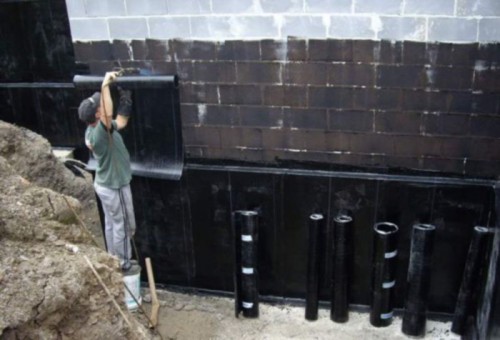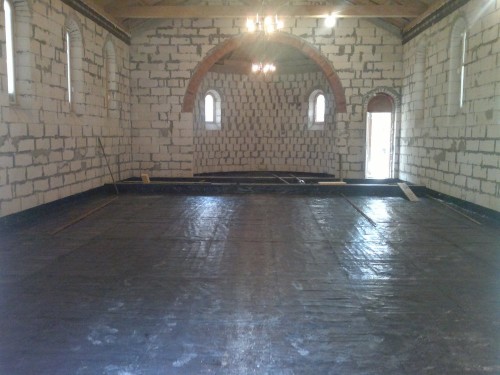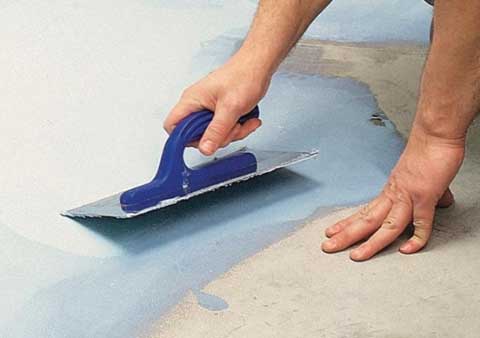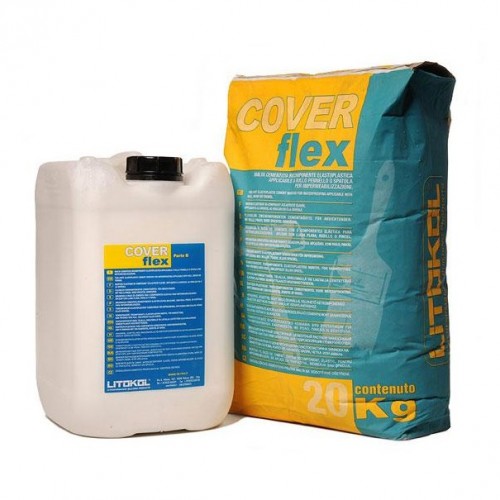If your house is built on a wet area, then you are definitely familiar with problems such as cracks on the foundation, a fungus and mold settled in the floor. The waterproofing will protect against these troubles. You will learn about the types and basic rules for applying coating waterproofing by reading this article.
Content
Pros and cons of coating waterproofing
Waterproofing coating usually consists of several layers. The thickness can be equal to both several millimeters and several centimeters. It depends on the state of the processed surface.
Advantages of coating waterproofing
- protects houses both from the inside and outside from groundwater, steam;
- increases the durability of buildings;
- work on its application is simple and can be done with your own hands;
- the protective surface is homogeneous, there are no joints;
- the possibility of applying to any surface;
- cheaper than other insulating materials;
- the work takes a little time.
Flaws
- poor resistance to mechanical influences;
- the waterproofing properties are lost if the house passes by the house or there is a railway station nearby, or the construction of a skyscraper has begun nearby.
Types of coating waterproofing
The following compounds are used as coating waterproofing:
- based on bitumen. The cost of such waterproofing is low, but there is a significant drawback: it is fragile at low temperatures. When laying bitumen coating waterproofing, it must be heated to 120 degrees S. serves no more than 6 years. Among other species - this is the cheapest;
- waterproofing coating, which has a bitumen-lactic base. It is plastic, heating during laying is not required, it is simple in use, fireproof, but in some cases, the basis must be reinforced;
- based on synthetic resin. Called bitumen-polymer. Very high -quality, durable, working with it is possible and at submarine temperatures up to -50 degrees S. deeply penetrates the processed surface. Before use requires meticulous preparation and preliminary primer;
- cement. It is economical, environmentally friendly, unsuccessful, durable and easy to use. There are but: we need work skills, otherwise it is difficult to apply it correctly;
- cement-polymer mastic. Cement and synthetic components provide it with high adhesion to the surface and resistance to bending, so it is used on ceilings. The surface is prepared before application. Her price is quite high.
The waterproofing of the foundation
The waterproofing of the foundation of the coating must be performed in any case, since it accumulates moisture from the soil that can destroy it.
Which material to choose
When choosing waterproofing, you must decide:
- with the temperature regime, which will prevail during the period when you are going to work;
- where you will use the material: outside or isolate the foundation inside the basement;
- with the size of the area that must be isolated. Based on the area, we determine the consumption;
- with loads on the processed part of the foundation.
Types of waterproofing materials used for the foundation
Professional builders divide waterproofing into type 3. One of them is anti -capillary, and the other two are anti -water:
- light. It is used where groundwater is below the level of the foundation. In this case, soils are most often sandy or sandy loam. The role of this waterproofing is to protect the foundation from capillary moisture;
- average. Designed for foundations erected on clay and loam, which keep moisture for a long time, preventing it from leaving to the depths;
- heavy. The use of this type of waterproofing is advisable where groundwater is high and put constant pressure on the foundation. Apply this protection at least 4 mm layer. It is necessary to reinforce with a fiberglass mesh of 2 layers.
Please note: Some packages may indicate the classification of the material used by specialists.
Rules for applying lubricant waterproofing to the foundation
Having bought a liquid waterproofing mixture, fulfill all the conditions agreed upon by the manufacturer, and besides:
- we apply waterproofing with a brush, roller or spatula;
- if it has rained, then proceed to work at least 4 hours to work;
- the surface of the foundation is aligned if possible, remove sharp edges so as not to violate the tightness of the coating;
- if it is anti -capillary waterproofing, then apply it with a layer of 1 to 3 mm;
- a medium -type waterproofing layer sometimes reaches 5 mm;
- depending on the characteristics of the heavy waterproofing mixture, it is applied with a layer of 2 to 6 mm;
- make sure that the layer has the same thickness throughout the area;
- for 10-12 hours, it is necessary to protect something from the sun or possible rain with something, and when it grabs a little, the protection is removed. Complete drying occurs after 2-3 days.
Important: In the process of applying waterproofing, it is necessary to control its thickness. Measurements should be performed pointily diagonally.
We protect the waterproofing
When the backfill of the pit is performed, there is a risk of damage to waterproofing, so it is better to protect, while the waterproofing mixture does not contain organic solvents, then an extruded or ordinary polystyrene foam for light and medium waterproofing and a profiled membrane are used as a protection. 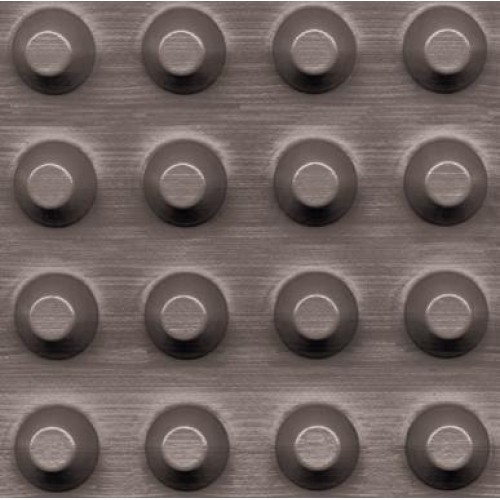
It is successfully used for coating waterproofing of the foundation waterproofing mixture of Kreisel Dichtungsschlämme 810. It is produced in Germany:
- used both outside and inside;
- diluted with water. After preparation, it is necessary to implement within two hours;
- applied at a temperature of 5 to 25 degrees C;
- made on the basis of Portland cement. Contains additives in the form of polymer binder materials, mineral fillers, modifiers;
- it takes 3 hours to dry for the first layer. For the next layers, time can increase by 1 hour;
- focusing on operating conditions, a layer of 2 to 5 mm is applied;
- the quality of waterproofing will intensify if, before applying it, to primed the surface of acrylic facade primer from the same manufacturer.
Crystal waterproofing floor
Crystal waterproofing on the floor will protect the house from dampness, and if it is an apartment, then it is necessary in the bathroom and as protection against moisture, and as a armor from the flooding of your neighbors.
Preparatory stage
It is not worth applying isolation on the move. At first:
- clean the surface: remove the dust with a vacuum cleaner, clean the floor from all kinds of extraneous spots, because the adhesion can worsen because of them;
- be sure to align. Unevenness only up to 2 mm are permissible. If there are large cracks, then cement them;
- install the beacons and make the leveling screed with strips 2-3 m wide;
- when the screed grabs, apply a primer using a brush or spray;
- if you have chosen coating waterproofing for the floor in the form of a dry mixture with a cement base, then dilute it in water. The proportions are indicated on the packaging. After 5 minutes, stir the solution again. It should be homogeneous.
Application of coating waterproofing
You need to use a solution on a cement basis for 1.5 hours, so we will immediately begin:
- we apply the first layer;
- after 5 hours, you can start applying the second layer. At the same time, we apply it perpendicular to the first, so that the gaps between the strokes are minimal;
- if the coating waterproofing of the floor is performed on a bituminous or bitumen-polymer basis, then a screed is filled on top of it.
So that when buying coating waterproofing, the price corresponds to quality, choose trusted manufacturers. Good reviews about two-component waterproofing of coating elastic-plastic Litokol Coverflex from the Italian manufacturer Litokol:
- it has good clutch with both porous and dense surfaces;
- cement base;
- resistant to chemical effects;
- it is applied with two cross layers. Interval between procedures - 3 hours, if the room is not lower than 23 degrees C;
- it is used in the temperature range of 5-35 degrees C;
- for applying 1 mm layer with an area of \u200b\u200b1 sq. It takes 1.6 kg of the mixture.
This video shows how to apply coating waterproofing in the bathroom:

